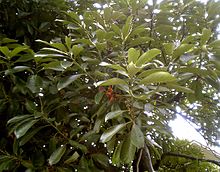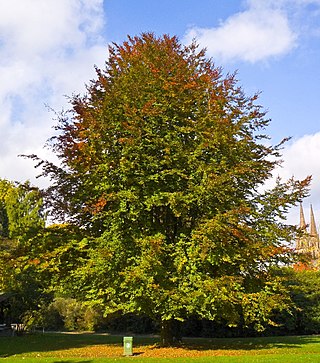
The Fagaceae are a family of flowering plants that includes beeches, chestnuts and oaks, and comprises eight genera with about 927 species. Fagaceae in temperate regions are mostly deciduous, whereas in the tropics, many species occur as evergreen trees and shrubs. They are characterized by alternate simple leaves with pinnate venation, unisexual flowers in the form of catkins, and fruit in the form of cup-like (cupule) nuts. Their leaves are often lobed, and both petioles and stipules are generally present. Their fruits lack endosperm and lie in a scaly or spiny husk that may or may not enclose the entire nut, which may consist of one to seven seeds. In the oaks, genus Quercus, the fruit is a non-valved nut called an acorn. The husk of the acorn in most oaks only forms a cup in which the nut sits. Other members of the family have fully enclosed nuts. Fagaceae is one of the most ecologically important woody plant families in the Northern Hemisphere, as oaks form the backbone of temperate forest in North America, Europe, and Asia, and are one of the most significant sources of wildlife food.

A nut is a fruit consisting of a hard or tough nutshell protecting a kernel which is usually edible. In general usage and in a culinary sense, a wide variety of dry seeds are called nuts, but in a botanical context "nut" implies that the shell does not open to release the seed (indehiscent).

The pinyon or piñon pine group grows in southwestern North America, especially in New Mexico, Colorado, Arizona, and Utah. The trees yield edible nuts, which are a staple food of Native Americans, and widely eaten as a snack and as an ingredient in New Mexican cuisine. The name comes from the Spanish pino piñonero, a name used for both the American varieties and the stone pine common in Spain, which also produces edible nuts typical of Mediterranean cuisine. Harvesting techniques of the prehistoric American Indians are still used today to collect the pinyon seeds for personal use or for commercialization. The pinyon nut or seed is high in fats and calories. In the western United States, pinyon pines are often found in pinyon–juniper woodlands.
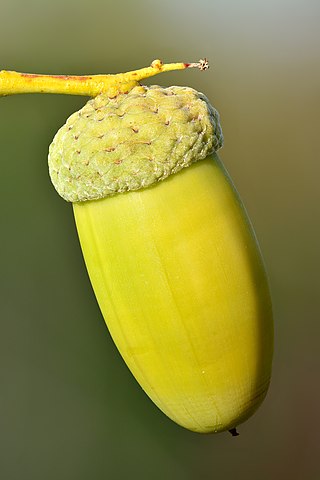
The acorn, or oaknut, is the nut of the oaks and their close relatives. It usually contains one seed, enclosed in a tough, leathery shell, and borne in a cup-shaped cupule. Acorns are 1–6 cm long and 0.8–4 cm on the fat side. Acorns take between 5 and 24 months to mature; see the list of Quercus species for details of oak classification, in which acorn morphology and phenology are important factors.

Lithocarpus is a genus in the beech family, Fagaceae. Trees in this genus are commonly known as the stone oaks and differ from Quercus primarily because they produce insect-pollinated flowers on erect spikes and the female flowers have short styles with punctate stigmas. At current, around 340 species have been described, mostly restricted to Southeast Asia. Fossils show that Lithocarpus formerly had a wider distribution, being found in North America and Europe during the Eocene to Miocene epochs. The species extend from the foothills of the Hengduan Mountains, where they form dominant stands of trees, through Indochina and the Malayan Archipelago, crossing Wallace's Line and reaching Papua. In general, these trees are most dominant in the uplands and have many ecological similarities to the Dipterocarpaceae, the dominant lowland tree group. These trees are intolerant of seasonal droughts, not being found on the Lesser Sunda Islands, despite their ability to cross numerous water barriers to reach Papua.
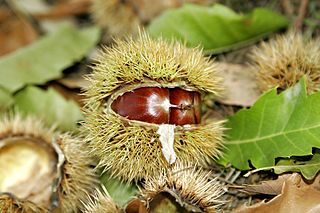
The calybium and the cupule make up the accessory fruit of flowering plants in the family Fagaceae. These two parts derive from different flower components.

Lithocarpus cleistocarpus is a species of stone-oak native to China. The flowers are white, and the nuts are flat, contained in a capsule. The tree is grown as an ornamental plant.
Aimée Antoinette Camus was a French botanist. She was best known for her study of orchids and oaks. Camus also has the legacy of authoring the second highest number of land plant species among female scientists, in total naming 677 species.
Edulis, edible in Latin, is a species name present in a number of Latin species names:
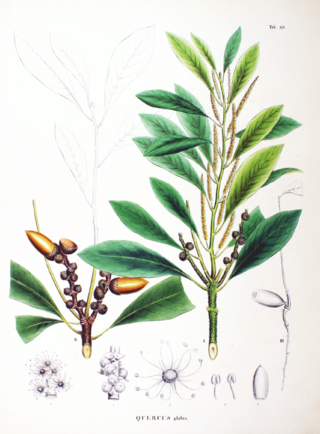
Lithocarpus glaber, the Japanese oak, is a tree species in the genus Lithocarpus found in Japan, China and Taiwan.
Cryptolectica pasaniae is a moth of the family Gracillariidae. It is known from Hong Kong and Japan.

Notholithocarpus densiflorus, commonly known as the tanoak or tanbark-oak, is a broadleaf tree in the family Fagaceae, and the type species of the genus Notholithocarpus. It is native to the far western United States, particularly Oregon and California. It ranges from 15–40 meters in height, with a trunk diameter of 60–190 centimeters.
The Japanese temperate rainforest is located in the Japanese archipelago, in small batches over a wide range of islands, from Kyushu in the South to Hokkaido in the North. Due to its geographic features and climate, the Japanese temperate rainforest is very different from other temperate rainforests in the world. The islands in the Japanese archipelago comprise about 1/400 of the world’s land. The islands are located on a latitude that is normally dry; desert can be found elsewhere in the world at this latitude. However, the oceans surrounding Japan provide enough precipitation to maintain a temperate rainforest.
Lithocarpus encleisacarpus is a tree in the beech family Fagaceae. The specific epithet is from the Greek meaning "enclosed fruit", referring to the acorns and cupules. The cupule is not fused to the nut though and often becomes irregularly dehiscent. The degree to which the nut is enclosed by the cupule varies across its geographic range. Trees in Lithocarpus are commonly known as the stone oaks and differ from Quercus primarily because they produce insect-pollinated flowers.
Dolichoprosopus sameshimai is a species of beetle in the family Cerambycidae. It was described by N. Ohbayashi in 2001. It is known from Japan. It feeds on Lithocarpus edulis.
Lithocarpus jacobsii is a tree in the beech family Fagaceae. It is named for the Dutch botanist Marius Jacobs. Trees in Lithocarpus are commonly known as the stone oaks and differ from Quercus primarily because they produce insect-pollinated flowers.

Lithocarpus ruminatus, the ruminate stone oak, is a species of stone oak, native to the island of Borneo.
Lithocarpus revolutus is a tree in the beech family Fagaceae. The name is derived from the way in which the margins of the leaves are typically rolled in upon themselves (revolute). Trees in Lithocarpus are commonly known as the stone oaks and differ from Quercus primarily because they produce insect-pollinated flowers.
Castanopsis sclerophylla, the Chinese tanbark-oak, is a species of flowering plant in the family Fagaceae, native to southern China. In the wild it is typically found growing in broad-leaved evergreen forests at 200 to 1,000 m above sea level. It is an evergreen tree with glossy, thick leaves and attractive flaky bark, and reaches 20 m (66 ft) in height.
